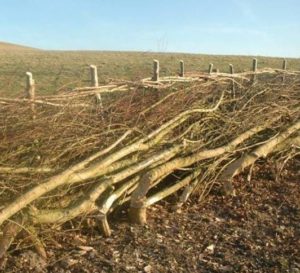Getting ready for winter at Earth Trust
By Earth Trust
Over the winter months our green spaces go through dramatic changes. It can appear to be a quieter time where, like nature, we can hunker down until the warmer days of spring. In fact, the autumn and winter months can be some of our busiest, with activities like hedgelaying best done at this time. So, what might you see if you’re visiting over the next few weeks, and why are we doing it?
—
Coppicing

Stakes and binders from coppicing are then used for hedgelaying, further supporting Earth Trust’s wildlife conservation efforts.
Already the team have started ride-side coppicing in Little Wittenham Woods. This takes place every winter, rotating the areas coppiced every five to seven years to create varied woodland habitat and encourage biodiversity. Coppicing is a traditional method of woodland management which takes advantage of the fact that many trees can regrow from the stump or roots. In a coppiced wood, younger trees are cut to near-ground level, and the new growth that follows is used to make products like stakes and binders for hedgelaying.
Coppicing also lets more light through to the woodland floor which is important for species like bluebells, wood anemone, germander speedwell, and violets. After a few years, brambles and climbing plants such as honeysuckle take over. These are a great source of food and shelter for many birds and mammals. As coppicing mimics the natural process of mature trees falling due to old age or wind blow, within some of Earth Trust’s coppiced areas we also fell larger trees, and use the timber for heating the office.
Any material that isn’t used for hedgelaying or heating is stacked up into ‘habitat piles’, which we leave in the woodland to slowly rot down. These provide food and shelter for many woodland creatures including woodlice, hedgehogs and even nesting birds in the spring.
Hibernation habitat

In camouflage: a newt found during clearing before being taken to a new winter habitat.
Earlier this year we shared that our River of Life II project had to be delayed due to the impacts of Covid-19. Our plans included digging ponds in Little Wittenham Woods, which is a site of Special Scientific Interest (SSSI) due to its amphibian and odonata (flying insect) populations. The delay means that over the winter we need to keep the area as amphibian ‘unfriendly’ as possible to reduce the impact of digging there next year.
To do this, our land management team have been working with volunteers (keeping socially distanced) to clear vegetation in this area by scything, brushcutting and raking (pictured above). This will open up the site and make it less appealing to hibernating amphibians which prefer damp places with lots of cover. Any frogs, toads or newts found while doing this work have been moved to suitable areas nearby. Providing plenty of ideal hibernation habitat for amphibians and other animals is essential to make sure that they’re supported through the winter months, and plays an important role in Earth Trust’s conservation work.